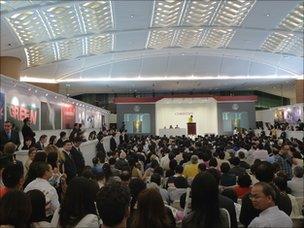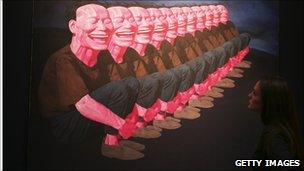China flexes its muscles in the contemporary art market
- Published

This picture by Fang Lijun went for three times its original estimate
Standing at the back of the packed sale room, the Chinese man, casually dressed in a green shirt, was barely visible to the auctioneer.
Undeterred, and helped by gesturing bystanders, his paddle finally caught the auctioneer's gaze and, after some fierce bidding, he paid 21.9 million Hong Kong dollars ($2.8m; £1.7m) for the monochrome oil canvas of two bald, quizzical men, by Fang Lijun - three times more than the pre-sale estimate.
Other bidders at the sale of Chinese and Asian contemporary art, in Hong Kong last week, complained security guards had refused them entry into the main sale room, saying it had been dangerously overcrowded.
They, like collectors and investors elsewhere, are clamouring for a slice of the white-hot market for Chinese contemporary art.
Soaring prices
The total value of contemporary Chinese art sold at auctions has grown from less than $1m in 2002 to $167.4m in 2010, according to figures from art-market advisory company ArtTactic.

Auctions of Chinese art attract huge crowds
"And this figure could easily be double if you take account pieces sold through galleries and art fairs," said ArtTactic managing director Anders Petterson.
The Christies evening sale of Asian 20th Century and contemporary art raked in 484 million Hong Kong dollars, an increase of 74% from a similar sale in Autumn 2010.
In April, a three-panel oil painting by Zhang Xiaogang sold in Hong Kong for 79 million Hong Kong dollars - a record auction price for Chinese contemporary art.
And knock-offs of pictures by artists such as Yue Minjun in tourist markets in China and Hong Kong are also testament to the market's rising popularity.
Blistering pace
It is not just the big hitters such as Zhang Xiaogang, Zeng Fengzhi and Ai Weiwei that are seeing the value of their art soar.
Even relatively little known Chinese artists are seeing the prices of their work rise sharply.
"The speed of everything is quite frightening," said Alistair Hicks, an art adviser and curator for Deutsche Bank.
"As a collector, you can blink and miss the moment."
Mr Hicks said Deutsche Bank had planned to buy a photographic collage by Shanghai-based artist Yang Yongliang, on display at the Hong Kong International Art Fair, but at $40,000 the price sought by the gallery was now too high.
He said the bank had bought a similar, albeit smaller, piece by the same artist a year ago for a fraction of that price.
This blistering pace of growth has prompted talk a bubble might be forming similar to that seen in the market for Western contemporary art in 2008, before the financial crisis.

Knock-offs of Chinese contemporary art are common in tourist markets in Hong Kong and China
"People are not turning into passionate collectors overnight," said Mr Petterson
"It is a result of new, investment-orientated money flowing into the art market."
For China's freshly minted millionaires and billionaires looking to spend their wealth, art is a natural choice.
Lacklustre returns on the country's stock markets and limits on the property market, make more traditional investments less appealing.
At least three Chinese financial institutions have set up funds investing in Chinese art, evidence of the newfound interest in art as an asset class in China.
Richard Chang, a New York-based hedge fund manager and collector, said he regarded his contemporary art collection as a hobby, but added: "No collector wants to lose money.
"When a nation is very wealthy and there's a lot of growth, oftentimes the art market goes along for the ride," he says.
Others say talk of a bubble is premature.
"There is a difference between speculation and investment," says Magnus Renfrew, ART HK's fair director.
"The prices we are seeing at the moment are underpinned by curatorial and critical acclaim."
Evolving tastes
Many Chinese collectors favour traditional and classical art forms by artists little heard of in the West, despite the high prices their work commands.
A picture by the artist Qi Baishi painted in the 1940s was sold at an auction in Beijing for more than $65m.The picture depicts an eagle on a pine tree, flanked by calligraphy.
"We are now reaching prices that even Picassos are struggling to get," said Mr Petterson.
Chinese collectors have been more wary of buying pieces by the more avant-garde artists, championed by Western collectors such as Charles Saatchi and Uli Sigg.
Signs are this is beginning to change, although there remain artists such as Ai Weiwei and Cao Fei that still only have a high profile in Western art circles.
Of the top 10 lots at the Christies evening auction in May, nine were bought by Asian companies or individuals.
This trend should make the current boom in Chinese contemporary art more sustainable, said Mr Hicks.
"To a certain extent, you are always going to have a greater affinity with art from your own culture," he says.
"The most likely person to spot and support a rising star is someone who shares, at least in part, their cultural background."
- Published14 March 2011
- Published26 May 2011